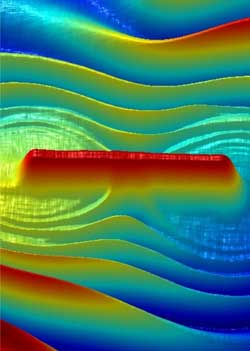

Recently, researchers from the Hahn-Meitner-Institute (HMI) in Berlin in cooperation with the University of Aplied Science in Berlin have succeeded, for the first time, in a direct, three-dimensional visualisation of magnetic fields inside solid, non-transparent materials. This is announced by Nikolay Kardjilov and colleagues in the current issue of the journal Nature Physics, the on-line contributions to which will be released in advance on the 30th of March at 18.00 London time.
The researchers in the imaging group used neutrons, subatomic particles that have zero net charge, but do have a magnetic moment, making them ideal for investigating magnetic phenomena in magnetic materials. When in an external magnetic field, the neutrons behave like compass needles, all aligning to point on the direction of the field. Neutrons also have an internal angular momentum, often referred to by physicists as spin, a property that causes the needle to rotate around the magnetic field, similar to the way in which the Earth rotates on its axis. When all of the magnetic moments point in the same direction then the neutrons are said to be spin-polarised. If a magnetic sample is irradiated with such neutrons, the magnetic moments of the neutrons will begin to rotate around the magnetic fields they encounter in the sample and the direction of their spin changes.
Kardjilov's group used this phenomenon as a measurement parameter for tomography experiments using two spin polarisers (which only allow the passage of neutrons whose spin points in a specific direction) to polarise and then analyse the neutrons. By detecting changes in the spins, it is possible to “see” the magnetic fields within the sample.
Kardjilov explains this by comparison with a medical CT scan; when a specimen is irradiated with x rays the density of the materials present alters the intensity of the light. “It's the same with our magnetic specimen, which changes the spin rotation of the neutrons”, says Nikolay Kardjilov. “The equipment only allows passage of neutrons with a specific spin rotation, and this generates the contrast according to how the magnetic properties are distributed within the specimen. By rotating the specimen we can reconstruct a three-dimensional image.”
Since 2005, Nikolay Kardjilov has built up the neutron tomography section at HMI and now his group is the first to use spin rotation as a measurement signal for three-dimensional imaging. Normally, neutron imaging relies on the different levels of absorption of radiation by different materials to produce contrast. The measurement of magnetic signals is a novel concept and its success lies partly in the polarisers and analysers, and the detector system, which have been developed and built by the HMI researchers.
Magnetism is one of the central research fields at HMI. To understand high temperature superconductivity, for example, it is vital to understand how magnetic flux lines are distributed and how these flux lines can be established in the material. With Kardjilov's experimental setup, it is now possible, among other things, to visualise magnetic domains in magnetic crystals three-dimensionally.
At Hahn-Meitner-Institut in Berlin work about 800 employees, among them about 300 scientists. They research properties of materials, develop solar cells of new generation and practice a user facility at research reactor BER II open to the national and international community.
To 1. Januar 2009 the HMI will merge with BESSY, the Berliner Elektronenspeicherring- Gesellschaft für Synchrotronstrahlung becoming together a new research center, the Helmholtz-Zentrum Berlin for materials and energy.
The Hahn-Meitner-Institut Berlin is member of the Helmholtz-Association, the biggest german research organisation. It involves 15 research institutes and 24.000 employees.
contact: HMI
Glienicker Str. 100
14109 Berlin
Dr. Nikolay Kardjilov
Tel.:8062-2298
e-mail: kardjilov@hmi.de
Press and PR:
Dr. Ina Helms
Tel.: 8062-2034
e-mail:ina.helms@hmi.de












